Extra-Thematic Levels: The Carnival of Oddities
MONDO
Mondo is the only level in the game that is truly bewildering from a design perspective. Now, it makes sense that the Special zone would be the place where weird things happen in levels. The player probably won't access the Special zone until deep into the game after accumulating lots of skills, and completion of the zone is not mandatory by any means. That said, all of the rest of the levels in the special zone are weird (generally because they are extreme), but theyíre also basically coherent. Sometimes that coherence is still unfair, but at least it makes some kind of sense. Mondo is both incoherent and unfair, although this unfairness can be exploited.
The baffling element in this level is the variable water level, and in particular, the period of its variability and its directional momentum. The water level will change, from a depth of 6 above the base height of the ground to nothing, and then will cycle back in about 35 game-seconds. (The first cycle is different, but the rest are fairly regular.)



The water does more than institute the normal water physics; this water has a direction. While in the water, Mario's momentum going toward the level's end will be reduced to the speed of underwater walking. This environmental shift in directional momentum can make even the simplest tasks very annoying, as the skills the player has been using all game are now befuddled by an element present in no other level. In this regard, the level has much in common with Tubular.
The reason why this is baffling and not merely bad is the water level is on a timer and not synced to Mario's location. The player will often be forced to deal with a Flying Hammer Brother while Mario is being pushed backwards by the water (an effect the enemies do not experience, naturally). This is unnecessarily difficult, but all the player has to do is wait for the water level to go down and the challenge becomes significantly more reasonable.


There are obvious problems with waiting 15 seconds. For one thing, it's boring, and being boring is one of the worst crimes a game can commit. For another thing, these extra waiting periods mess up the theoretical timing of the level. If the player continually presses forward without any waiting period, the water sections tend to line up with some geographic features that make it seem like the timing is somehow appropriate. But then there are sections like these which donít make sense in this scheme. Are these sections supposed to be wet or dry?


These pits are ten blocks wide, making them the longest pits in the game not mitigated by some powerup or other gravity-defying factor like a balloon, springboard or pipe-cannon. In essence, this is the kind of challenge perfectly suited for the end of a game. The problem is that the presence of the water makes these jumps somewhat of a non-challenge, or at least a very bizarre one. Why are those two blocks present above the second big pit if the water is supposed to rise? Or is it not supposed to rise at all? The level might have made more sense if the water had been linked to location instead of time, but maybe this was a technological impossibility. Whatever reason they might have had for making the odd decisions they did, the design team rolled out a weird one in this level.
CHOCOLATE ISLAND 5
Although Chocolate Island isnít in the Special zone, I think it probably would have been if the designers had the space. Chocolate Island 5 takes two cadence-unfriendly ideas and makes a whole level out of them. The first idea in play is the P-Switch puzzle, which is stretched out across half a level. This puzzleís trick is convincing the player to hit the switch as soon as Mario stumbles upon it, and to that end the level makes it very obvious that a P-Switch is coming.

The obvious message is clear: hit a P-Switch and all of this will become available. I like this as a psychological effect because it tricks the player into making a stupid, knee-jerk reaction. Obviously, those empty coin-blocks will transform after the switch is hit, but why would the player want to actually do this? To free all the Spiny enemies inside those blocks? Less obviously, if the player actually thinks about the effect of the switch instead of simply reacting, he or she will notice that the switch either shouldnít be hit or that there might be a better opportunity later. And there is! By bringing the switch toward the roulette block, the player can get a star and possibly a series of 1-ups.

This is where the identification with the Special zone is the clearest from a design perspective. In order to know exactly what the level expects from the player (ideally, to collect the star and then chain some 1-ups together), the player probably has to have already seen what lies ahead, because thereís no clear precursor to this odd configuration. The geographic hurdle here is that the first bridge made by the P-Switch is rather uneven, slowing the playerís progress. The player doesnít know that itís really progress, though, because they havenít seen the treasure trove of Koopa shells ahead that could result in as many as four or five extra lives. This would be totally acceptable in a Special zone level, because those levels do weird, tricky and extreme things with the design of the game; thatís the point of the zone. But this is the last level in Chocolate Island, and while itís a nice break from the increasing difficulty of the game, itís still a little unusual, stylistically.
The second part of the level is also a little strange. While most of Chocolate Island has been about taking earlier ideas and expanding and evolving them, this section does something more extreme. This jump, located at the end, is a fairly tough jump.
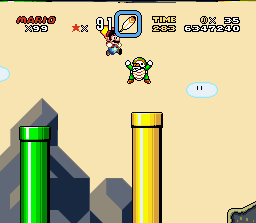
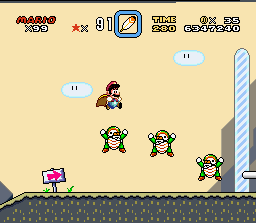
Because the Snapping Chuck is programmed to make its jump only when Mario is in range, the player has to shape Marioís jump so that Mario is still four blocks above the pipe (and the Chuck) after heís cleared five blocks of d-distance. Itís not an impossible jump, but it is difficult, and the player also has to make sure not to start jumping when the moveable pipe Mario is standing on begins to sink. It seems almost as if it could fit somewhere else more appropriately. And if that werenít enough, there are also these Chucks at the end, which are very reminiscent of the end of Funky.
FUNKY
The apparent purpose of Funky was to allow the design team to get more use out of some enemies they liked: the Sumo Brother and the Alerting Chuck. Neither enemy sees much action outside this level, but they see plenty of development here. Although the level itself doesnít resemble any of the four central themes, it does exhibit a surprisingly normal challenge cadence. The level begins with a single Sumo Brother for the standard challenge (left) and evolves quickly (right).
The evolution is that now the player canít simply make a timed run through the Sumo Brotherís area; Mario has to either make a confined leap over the enemy or defeat him from below.


Next, we have an expansion that doubles the number of Sumo Brothers. Ignoring the unusual composition of the blocks (which is a red herring anyway), this is about as standard as the level could be.

The level has two enemies it wants to feature, and so the Alerting Chuck appears next. Although accompanied by a Pitching Chuck, the two are separated by a decent amount of space, and so this is probably best assessed as a second standard challenge for a level with two cadences, and weíll see the evolution in a bit.
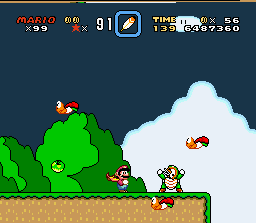
Next, the level goes back to an expansion upon the standard challenge (below, left). Although the Sumo Brother is vulnerable here, heís also a lot closer to the ground, meaning that Mario has less time to dodge the lightning bolt and less space to arc or hover above the fire. This will eventually evolve when some intercepts are added later from the immediately subsequent challenge. The evolution of the Alerting Chuck follows next.
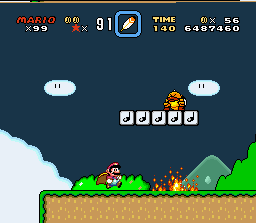
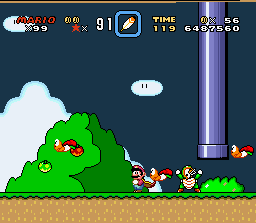
The second Alerting Chuck (on the right, above) is an obvious evolution via the terrain; now the player must hit and defeat the Chuck to pass by because of the confining pipe. Hitting the Chuck from above will alert the Super Koopas, though, and will not only make this challenge more difficult, but the next challenge as well.
There are two really significant challenges left, the first of which is what we might call the ďorthodoxĒ pinnacle challenge. This Sumo challenge is complicated by these Wing Goombas (left, below). This is the first time in the level another enemy has been added to a Sumo Brother challenge, and so clinically speaking itís the most complex. Itís a weak climax though, and so thereís a greater challenge yet to come.
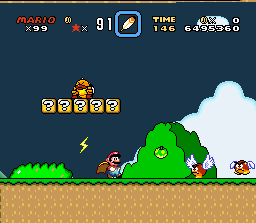
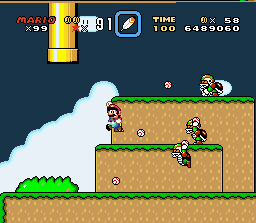
This wall of Chucks has nothing to do with the evolutions weíve seen so far, and so although itís outside the cadence, itís still the true culminating challenge of the level. The cadence here is rudimentary, which is a little strange. A spectacularly difficult final level seems like it would make more sense, but there have been plenty of those, and this level simply ties up a few loose ends in enemies Nintendo hadnít used enough.
VANILLA DOME 1
Vanilla Dome 1, much like the level that comes after it, does not exhibit the normal cadence structure we find in most levels. It does feature several sections that would fit easily into a skill theme, but because there's no progression in any thematic direction, the level doesn't belong to any of those themes. The probable "goal," or lesson that this level is supposed to teach the player, is how to deal with narrow corridors and low ceilings, and how those things affect jumps. Precisely controlling the height of Mario's jumps is a very important skill much later in the game. Although this level does not, except for one instance, call for a controlled-height jump, it nevertheless prepares the player for their use in several ways. This structure seems bizarre in the context of the game's skill themes, but makes sense from a perspective of low-height jumps.
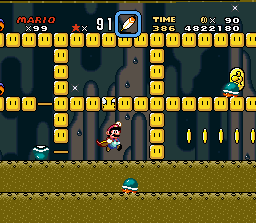
The Buzzy Beetle which moves along the lowest level of this structure will likely force Mario to jump, landing him in one of the "sealed" boxes. Although there's nothing particularly difficult about this challenge, it does put the player's mind on the fact that some jumps can be too high, and that it's important to note what's above Mario as well as in front or below of him. The second section teaches a similar lesson through different means. This section features a Super Star and a sinking platform. Like all sinking platforms and almost all stars, this is the mark of a preservation of momentum challenge, but the lesson the player needs to learn here isn't about that theme, it's about controlling the height of Mario's jumps.
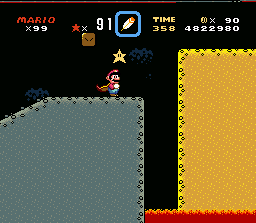

The raised hump in the terrain forces Mario, who must be running at full speed, to jump. And yet, in order to hit all of the enemies to get the 1-up, Mario's arc can't take him too far. (This is mostly problematic if the player is under the effects of the cape powerup.) By limiting the height of the jumpóand there are several ways to do thisóMario can not only survive the platform but also get the 1-up via the star.
The last section features some Spike Tops that continue to highlight the perils of low-ceilinged corridors. Although this whole level is somewhat atypical for the game, this section in particular is weird in that these enemies move so slowly.

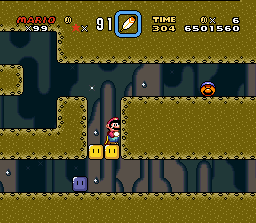
The corridors that follow are similarly dull and repeat the same low-ceiling idea again without any interesting ideas. If there is a filler level, or even a filler section of the game, it seems that this was it.
TUBULAR
The reason that Tubular is so infamous is not that it is merely difficult, but that it is difficult in a way that does not fit with the style of the game. It is difficult, relative to the rest of the game, but not that difficult relative to many other games in the same period or even many current indie platformers. Tubular has a combination of systemic and local problems that make it unique in Super Mario World, and so it feels wrong. Super Mario World has few systemic problems, and the ones that exist favor the player. The ability for sustained flight via the cape or Blue Yoshi is a game-breaking systemic problem, but they make the game easier, not harder. Moreover, the player could always simply not use them for the sake of enjoying all the ground-based content of the game. There are many local problems throughout the game too, and this text has highlighted many of them, but nowhere do the local problems compound more than in this level.
In Tubular, the systemic problem is that balloon powerup is badly implemented. The powerup isnít a great idea to begin with; itís so dissimilar from everything else in the game that it canít help but feel awkward. Wet and dry levels use vectors (the gameís gravity, more or less) differently, but nevertheless are very similar, even if max speed and acceleration physics act differently. The balloon powerup changes too many things.
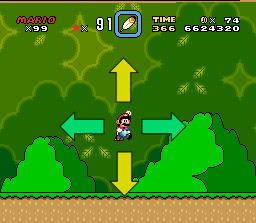
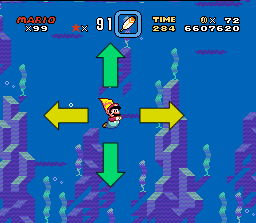

(Green arrows indicate a controllable vector. Yellow arrows indicate a fixed-speed vector. The red arrow is for a polarized vectoróone that actively fights the player.)
This illustration shows how wet and dry levels are really not that different. The biggest change from dry to wet levels is in downward acceleration, but as you can see the full force of this effect isnít felt except in the few situations where Mario drops a full-screen length, and the player can interrupt it with ease. Marioís ability to move laterally is slowed in water levels, but his greater ability to control his vertical position makes up for this, at least to some degree. The balloon powerup, meanwhile, limits Marioís movement even further and in stranger ways. Inverting the effect of the downward pull of the Ďgravityí of the game isnít a bad idea per se (although it does lead to a very, very big local problem in Tubular), but, matched with all of the other effects itís a problem.
The Balloon is a completely different story. Why did the designers think that it was a good idea to severely limit Marioís ability to move downwards in addition to slowing his lateral movement and even his upwards momentum? Why did they want to eliminate Marioís ability to accelerate completely? These things sound terrible in theory, and in practice they werenít much better. There are some places where this works passably. In Donut Secret 1, there is a bonus pipe-section that gives the player a balloon powerup to ascend to the top of a tall cavern. On the way up, there are a few patrolling Wing Koopas to make navigation interesting, but they're not dense. Because the player never has to go anywhere but up, the speed penalty on downward movement isnít an issue. Because the Koopas arenít dense or speedy, the lateral slowness isnít a huge problem either.

There's also a platform there on which Mario can land, before getting the second balloon to ascend the rest of the way. This forms the longest balloon-based challenge in the game (not counting Tubular), and the only one to involve more than one balloon in sequence. But besides the fact that this challenge is built around the movement penalties, itís also over a non-fatal fall. If Mario loses the balloon, he can still land safely. In other words, most of the problems with the balloon are mitigated by level design. The same is true in Donut Secret 2, in which there are intercepts and some dangerous d-distances, but also a safety net.

Falling here is not necessarily fatal, but whatís more important is that this distance is only one P-balloon long. But letís back up to Donut Secret 1 again: when Mario has to get a second balloon in that level, he gets to stand on a platform to do it. This mitigates the problems the balloon presents. And yet, this isnít a training-wheels challenge readying the player for an evolution to come soon: nowhere in the game before Tubular does the player have to seriously adapt to these problems. This section in Forest of Illusion 1 is so short that it too trivializes the problems the balloon has.
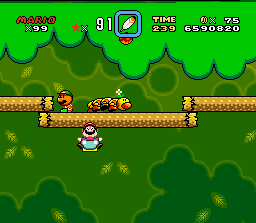
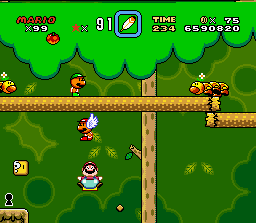
Thereís no gradation of challenge across the course of the three levels that have this powerup, just a sudden, sharp spike when the player reaches Tubular. And those are just the systemic, game-long problems.
The local problems begin about as soon as the player collects the P-Balloon powerup. One of the bizarre properties of the P-Balloon is that it comes closer to real-world physics in its applications than any other powerup. So when the player has to use the springboard to launch Mario toward the balloon, there's an unfortunate drop in altitude.
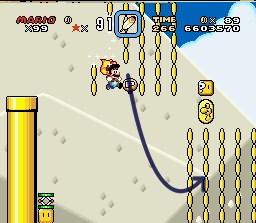
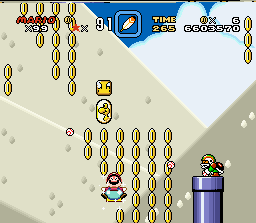
For whatever reason, the inherent lift of the balloon powerup has to slowly deplete Mario's downward motion instead of stopping it suddenly. This is closer to real-world physics than any interaction involving the cape or Yoshi wings or even the underwater physics. But apart from this break from previously established game-physics, the arc of this jump takes Mario immediately into danger, and does it in a way that the game usually wouldn't do. The two Pitching Chucks here would be tricky if Mario had full use of the ground; but with a balloon they're significantly harder because Mario's lateral movement is restricted, and there's no upward acceleration at all. The only really effective way to avoid this instant-death problem is to know beforehand that the Chucks are waiting off-screen, and anticipate the baseballs before they start flying.
This is just the tip of the iceberg, so to speak, because this challenge evolves and expands. The first evolution is an A + B evolution, which adds a group of Wing Koopas to the projectile challenge the player has just faced.


The projectile portion of the challenge has mutated, going from lateral baseballs to vertical fireballs, but it's still limited to a small portion of the screen, which is an important detailóitís still a challenge that the player can figure out on the fly. Adding the Wing Koopas means that a first-time player has to time the gaps between them and the Volcano Lotuses at once, which can be difficult, but at least the entire challenge is visible to the player at once.
The third challenge is the real disaster area, and the point at which the last of the systemic problems with the P-Balloon appears and combines with its biggest systemic problem. This challenge is probably supposed to be a mutation or slight evolution of the first balloon challenge, and if it weren't for the confounding problems with the powerup itself, it might not be much harder. As it stands, though, the whole thing is poorly conceived.
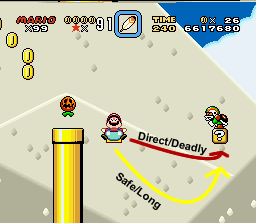
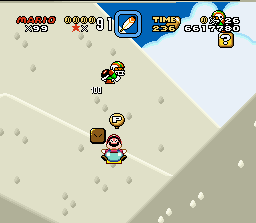
The path in the third challenge (left) is a problem because the Pumpkin pipe forces the player to descend not only downward, but at an angle. In the previous two challenges, the player could easily move in a straight line with proper timing or a couple of quick pauses, which made it easier to intuit the timing for both challenges. Here, the player needs to move Mario downwards and to the right at the same time, or else Mario wonít get the balloon in time. The problem is that these Kicking Chucks are calibrated so that they will hit Mario if the player guides him on the shortest path. Ergo, the player has to take Mario through a very specific path, one that is impossible to know before trying and failing the challenge several times.
This brings us to the overall ďanti-themeĒ problem: this level violates most of what makes Super Mario World what it is. Part of what made composite design so successful was that it helps designers flesh out the length and depth of their games without forcing players to fail dozens of times in the same spot in order to memorize and precisely execute the exact maneuvers necessary for survival. Super Mario World goes further than merely not forcing the player to repeat the same task over and overóit actively prepares players for future challenges by use of skill themes. (Though, again, the designers didnít intentionally create skill themes, they merely stumbled upon them after great effort, and kept them because they worked.) The ultimate experience of a Mario game is the moment in which the player sees a brand new, harder-than-ever challenge and nails it in one go because the skill themes have prepared his/her mind and thumbs for the moment so well. That experience of game-defining flow is the height of artistry in game design. But Tubular, especially in this third challenge, is the opposite of that.
VALLEY OF BOWSER 1
Although Valley of Bowser 1 does not belong in any particular theme, it does demonstrate several trends which illustrate the increase in qualitative complexity throughout the game. One of the first problems with trying to analyze this game was that the nuts-and-bolts numerical details didnít suggest a way that the game becomes progressively harder. Jumps donít keep getting wider, or higher or more filled with intercepts. Analysis of the skill themes shows, however, that the levels do change; Valley of Bowser 1 encapsulates the kind of changes that happen. The level itself strongly recalls Vanilla Dome 1 and 2, as it focuses on low-ceiling combat and maze-like features. Those things, because they are so scarce and so generally out of line with the style of the rest of the game, are not terribly interesting. What happens in the tunnels is of more import.
The most obvious level-to-level evolution is the presence of the Mega-Mole in a situation that actually means something. The Mega-Mole appears in Chocolate Island 4 and is completely forgettable. In that level, the Mole was a mere novelty thrown in to make an otherwise enemy-less level more energetic; it did not succeed especially well. That is not the case in Valley of Bowser 1, where there are some real problems that require unusual solutions.
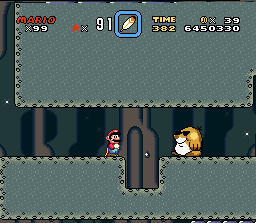

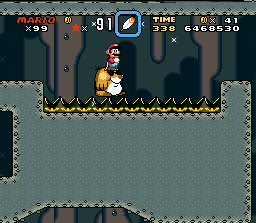
The player can backtrack, use the cape attack or Yoshiís tongue. Even though those are three solutions, the room for improvisation and choice is cut down; the corridor is that narrow. Itís also clear that thereís enough variety in these challenges that they might form a cadenceóexcept that theyíre not in linear sequence. In order to see every Monty Mole, the player would have to go through multiple optional paths in the level, and if backtracking is abnormal for a Mario game, thatís just unlikely. Still, the chain of Monty Mole ? Mega Mole ? Mega-Mole-in-meaningful-situations is a game-long example of challenge evolutions.
We shouldnít fault the designers of the game for building non-linear levels out of what would have made a perfectly good cadence. This level works well enough, and the designers need variety as much as the player does. This level might have made an interesting one for shifting between the Mega Mole and the Charging Chuck. Certainly, the Chuck challenges are a little more in line with the standard ideas of cadence progression, since this chain doesnít require as much backtracking and does feature a linear evolution.
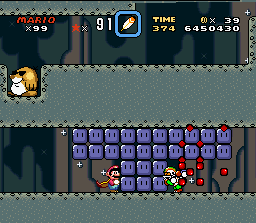

Here the player needs to manipulate the Chucks into breaking blocks to clear paths, and each challenge is different. The far left is too long and needs to be shortened by Mario a bit before the Chuck can be baited into saving the player some time. The second is a great evolution of this, but the player might not encounter this challenge at all. The overall trend for the gameóusing Chucks as puzzle pieces in dangerous situationsóis definitely a qualitative step up.
While this level has little to teach us about the design of Super Mario World levels, it has a lot to teach us about the game. The game gets harder when things become more complex. Sometimes this has to do with things that change quantitatively (such as the expansion-by-contraction of those narrow hallways), but itís much more often a change in qualitative complexity. The levels in Super Mario World evolve just as challenges in those levels do.
VANILLA DOME 2
Vanilla Dome 2 serves an example of why this book does not examine the design of secret exits in Super Mario World. Generally, secret entrances and exits are simply stationed somewhere along the linear path of a level, in places that the player might be unable to access at first, or which the player simply might not notice. There is no meaningful pattern in the secrets that spans the length of the game, and especially none in those levels which do not hide their secrets in any special way. In levels like Vanilla Dome 2, however, the designers went to greater lengths to involve the secret exit in the level's larger design. In essence, they created a maze, which is great for secrets but bad for consistent level design. There are few mazes in Super Mario World, and if Vanilla Dome 2 is any indication, it's because mazes disrupt the style of the game.
The properties of a real maze seem to be antithetical to skill themes, at least in the way that Super Mario World constructs mazes and skill themes. The kind of coherence needed by a simple maze and the kind of coherence that makes a skill theme are not the same. The sections of mazes need to be distinguishable from one another. This is probably why this level has both dry and wet sections.


The alternating wet and dry sections allow the player to remember more clearly where various paths and turns were located, and which ones the player has visited (and not visited). If the level had been all wet or all dry, the twists of the mazes might have been indistinct in the player's mind. Additionally, the alternating sections and gimmicky tricks (Chucks plowing through spin-blocks) in the level keep it interesting while the player searches.
The problem is that this kind of variety doesn't carry a theme well. Some levels have two standard challenges, and are able to develop both. This level has more "standard" challenges than that, and doesn't really develop any of them. The fish movement patterns suggest the periodic enemies theme. The uneven terrain and Beetles foreshadow some of the preservation of momentum challenges from Valley of Bowser. The Chucks and Swoopers later in the level are clearly pieces of intercept challenges.
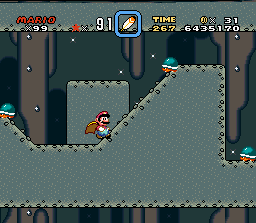
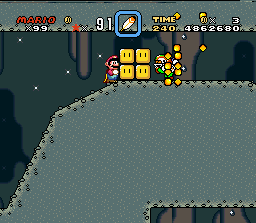
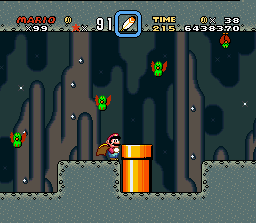
None of these challenges go anywhere, because it probably would be too taxing to expect the player to navigate a maze (even a simple one) while dealing with escalating challenges. These challenges are great, however, in giving the player cues about Marioís relative position in the level. Although not an evolution or expansion upon an earlier idea, the large number of enemies pictured on the far right tells the player clearly that Mario has left the maze.
There aren't many mazes or maze-like sections in Super Mario World, because it precludes use of the brilliant style that the game employs throughout. Evolutions and expansionsóthe bread and butter of Super Mario Worldóaren't easily implemented in a maze. Skill themes, the product of consistent use of expansions and evolutions, canít really emerge in such a level. That said, occasional variations in design are tolerable in small doses, and two levels in a game as big as this one is certainly a small dose.